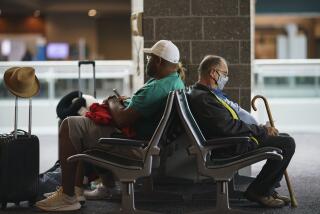Executive Travel : Pack Light, Drink Water, Walk Lots
- Share via
There is nothing worse than feeling under par while traveling. It is hard enough to manage time zone changes, navigate unfamiliar territory and eat well on a steady diet of hotel and banquet fare without also feeling sick and tired.
But there are some things you can do to stay fit when you travel. Here are some suggestions from doctors, chiropractors and physical therapists, as well as some exercises from the book, “The Business Traveler’s Guide to Good Health on the Road,” edited by Karl Neumann, M.D., and Maury Rosenbaum (Chronimed: 1994).
Before Boarding
Always pack as lightly as possible and try to avoid carrying anything onto the plane, especially if you have back problems, said Santa Monica-based chiropractor Shelly Roth, whose patients include numerous business travelers. Lifting a carry-on bag into the overhead bin can aggravate an existing back condition, or give you a new one.
“When you carry things on, you’re asking for problems,” she said. “Injuries can last forever. It’s just not worth it.”
Use porters at the airport whenever possible, or rent a baggage cart. And always buy suitcases with built-in wheels.
It’s also better to carry two smaller bags for balance than to try to cram everything into one heavy bag, Roth said.
Many of Roth’s patients are business travelers in their 40s who have been traveling and hauling luggage around extensively for 10 years, she said. Shoulder, neck and back pain have forced them to revise their travel habits, she said. They don’t take as much with them anymore.
On The Plane
“The first thing you should do when you get on a plane is grab as many pillows as you can,” Roth said. Use the pillows to “customize” the seat to your body. Put one pillow behind your lower back for support, and use the others to prop and stabilize yourself in a comfortable position.
In addition to pillows, some travelers like to use an inflatable cervical pillow that wraps around the back of the neck to support the head, said Dr. Myron Shapero, a former competitive marathon runner who practices family medicine in Los Angeles. Also, try sitting with your knees higher than your hips by propping your legs on something, he said. This takes pressure off your lower back.
And always wear comfortable, non-binding clothing that allows you to move and stretch. Taking your shoes off while sitting will also help keep your circulation moving. When seated, don’t cross your legs, which can cut off your circulation.
The most important factor in feeling better on a plane trip, however, is to not sit for prolonged periods, Shapero said. “Get up and walk as often as possible, at least every 30 minutes if you can.” Walk to the back of the plane, if possible, and do some standing stretches. The longer you are on the plane, the more frequently you should get up and walk around.
Sitting for long periods can cause swelling in your lower extremities and tension in other parts of your body, said Donna Beaver, physical therapist at Glendale Adventist Medical Center. To counter these effects, try some of these stretches while sitting:
* Raise your arms over your head with your fingers laced together, palms up, and hold for 15 seconds.
* Raise the elbow of one arm so your hand falls behind your head. Grasp the elbow with your other hand and pull down. Hold 10 seconds on each side.
* Rotate your head five times in each direction.
* Shrug your shoulders up and down several times to release tension, then rotate them backward and forward.
* Do trunk twists, turning to face the back of the seat with your hips squared and facing front.
* Rotate your wrists 10 times clockwise and counterclockwise.
* Shake out your hands.
* Rotate your ankles 10 times in each direction.
* Point and flex your feet. When you flex your foot, spread your toes.
* With your feet on the floor, pull up your heels, then lower them.
* Suck in your stomach and hold a few seconds, then release. Repeat as many times as you can.
* Exercise gluteal muscles and quadriceps by pressing your feet into the floor (with knees bent so legs are perpendicular to the floor) while tightening buttock muscles.
In addition to stretching and moving, make sure you drink plenty of water to counteract the fatiguing effects of dehydration. Also, eat lightly and avoid alcohol and caffeine, Roth said.
Some travelers now routinely order vegetarian meals in advance, which are typically lighter fare. Another trick is to eat yogurt to keep the digestive track healthy and head off potential travel-related stomach upsets.
At Your Destination
Make sure you exercise. If the place where you are staying doesn’t have a fitness center, break out your sneakers and walk. For information on walking for exercise, write the Walkers Club of America, 445 E. 86th St., New York, NY 10128.
If you prefer to jog, the American Running and Fitness Assn. in Bethesda, Md., has a list of running and exercise trails in cities around the country. (For information, or a trail map of your destination, call (800) 776-2732.)
One of the best all-around exercises while traveling is swimming. Water has a very restorative effect on the body, Roth said. Some swear that a bath or swimming session helps reset their biological clocks.
More to Read
Sign up for The Wild
We’ll help you find the best places to hike, bike and run, as well as the perfect silent spots for meditation and yoga.
You may occasionally receive promotional content from the Los Angeles Times.






